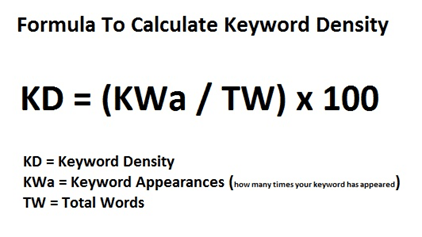What is Keyword Density?

Hand off the toughest tasks in SEO, PPC, and content without compromising quality
Explore ServicesHow does Google, or any other search engine, know what a web page is about?
How do they know to show one website instead of another in response to a searchers’ query?
Keyword density is one of the main factors indicating to search engines what a web page is talking about. But how can you use keyword density to maximize your rankings in search engine results pages (SERPs)?
In this article, you’ll learn:
- What keyword density is
- Why keyword density is important
- How to use keyword density to get the most out of your search engine optimization efforts
What Is Keyword Density
Keyword density is a metric that refers to the number of times a target keyphrase appears on a webpage. The metric is a frequency calculation that shows how frequently a keyword is used relative to the total number of words on a web page.

Leveraging keyword density correctly is a way that copywriters and digital marketers can create content that clearly signifies to search engines what the content of a particular web page is talking about.
However, it is essential that the content reads naturally, and that there is no keyword stuffing (the practice of writing high-density keyword content and crowbarring keywords in unnatural places where they don’t belong).
To get the most out of any piece of content, it should be written with natural language and an optimal keyword density that creates an enjoyable reading and user experience, both of which are essential on-page SEO metrics.
Why is Keyword Density Important?
Keyword density is important because it signifies relevance to search engines, but it also demonstrates readability.
To write content with the most natural language possible, copywriters often use keyword stemming and semantic keywords – or related terms that mean the same thing as a given keyword but avoid repeating the same phrase repeatedly. This helps search engines understand the topical relevance of a content piece without compromising the quality of the writing.
This practice ensures search engines understand exactly what a piece of content is talking about, so they can present it to relevant search queries.
Keyword Density FAQ
How do you calculate keyword density?
Keyword density is calculated as a relative percentage of all the words on the page:
Does keyword density still matter?
Keyword density still matters in that you want to avoid keyword stuffing at all costs. Creating content that is unenjoyable or is written with the goal of SEO in mind instead of the user will be punished by the Google algorithm.
As such, it’s best to focus first on writing valuable, readable material first, and then seeing if you can naturally put keywords or semantic keyphrases in amongst your content.
What is the ideal keyword density?
By and large, SEO experts agree that a keyword density of 1-2% is ideal. This is so that content remains readable and search engines can identify what your page is about.
What is keyword frequency?
Keyword frequency is similar to keyword density, only it isn’t a percentage – it is simply the number of times a specific keyword appears.
How do you increase keyword density?
You can increase your keyword density simply by using your target keyword more often. However, this isn’t necessarily advisable as it might be perceived as keyword stuffing by search engines, and your web page might be penalized in the SERPs because of it.
What is keyword cannibalization?
Keyword cannibalization is when you have too much content on your website targeting the same specific keywords. This makes it hard for Google search to decide which page to rank – and in some cases, it will simply choose to rank a page from a different domain.
This is why having a planned SEO strategy for particular keywords through various pieces of content is essential for digital marketing. Webmasters need to approach their content writing content strategy and content marketing with the right keywords from the beginning – this avoids any keyword cannibalization.
Summary
Hopefully, this article has given you a better understanding of keyword density.
The take-away message is that you should be creating online content around the right keywords that helps your audience first. Ensure you research your keywords first, and then create high-quality content with high readability.
Once your article is finished, you can then start looking at the density percentage of your keywords and how you want to target particular search terms. In general, aim for 1-2% keyword density, and your page should be ranking in no time!
Hand off the toughest tasks in SEO, PPC, and content without compromising quality
Explore ServicesWritten by Adam Steele on July 7, 2021
COO and Product Director at Loganix. Recovering SEO, now focused on the understanding how Loganix can make the work-lives of SEO and agency folks more enjoyable, and profitable. Writing from beautiful Vancouver, British Columbia.






